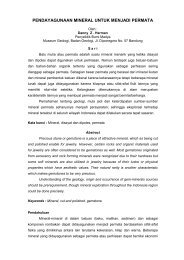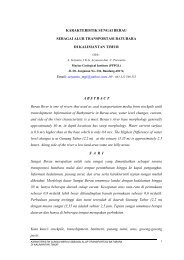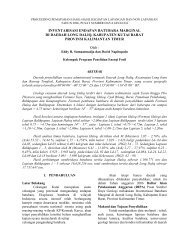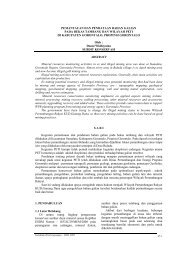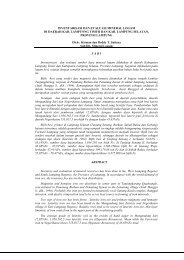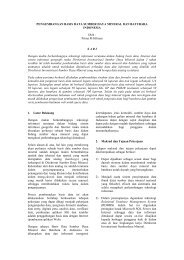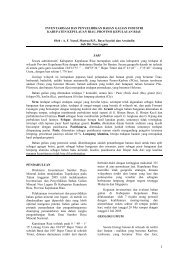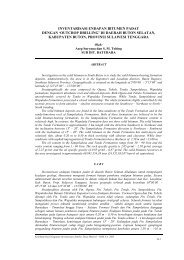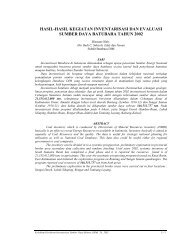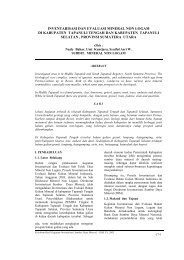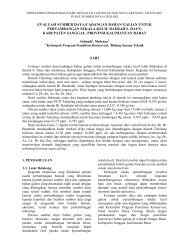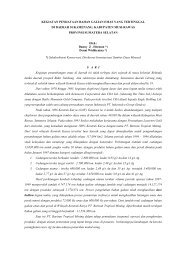MAKALAH ILMIAH - Pusat Sumber Daya Geologi
MAKALAH ILMIAH - Pusat Sumber Daya Geologi
MAKALAH ILMIAH - Pusat Sumber Daya Geologi
You also want an ePaper? Increase the reach of your titles
YUMPU automatically turns print PDFs into web optimized ePapers that Google loves.
<strong>MAKALAH</strong> <strong>ILMIAH</strong>Kerusakan pada pori-pori batuan akibat proses diagenesis terlihat dari adanya struktur bilahpada semen, sedangkan perkembangan diagenesis pada porositas ditandai oleh strukturmikrofraktur yang diasumsikan terbentuk oleh proses kompaksi akibat sedimentasi cukupdalam dan pelarutan matriks pada beberapa sampel.Integrasi hasil analisis petrografi dan sampel batuan menunjukkan kualitas batuan karbonat dariparameter permeabilitas dan porositas batuan. Berdasarkan analisis dari tiga mikrofasies,didapat nilai porositas berkisar antara 5,26-17,32% (rendah – baik) dan permeabilitas antara0,041 – 7,27 mD (sedang – buruk). Kualitas batuan karbonat dipengaruhi oleh proses diagenetikyang menyeluruh pada setiap litofasies.Kata kunci : fasies, diagenesis, Formasi Tabalar, Formasi Tendehantu, karbonatINTRODUCTIONMangkalihat peninsula is locatedbetween Kutai and Tarakan basins, whichknown as two HC Prolific basin in EasternBorneo. The petroleum system is poorlyknown because of the different systembetween Kutai and Tarakan (Figure 1). Fieldstudy is focusing in the eastern part ofMangkalihat Peninsula, where The Tabalarand Tendehantu are exposed. The locationwas chosen as a key to conduct the tectonicunderstanding related to petroleum systemin this area. The study is a compilation of fieldstudy data for preliminary reservoirprediction based on outcrop data,petrographic thin section analysis and plugsample porosity, permeability estimation topredict the reservoir candidate.METHODOLOGYThis study is integrated from the resultfrom field work, there are 29 spots of outcrop2station for analysis in 10 km area in EasternMangkalihat. The outcrop samplesfurthermore were selected and grouped bythe lithofacies based on outcropanalysis.The representing samples fromsome facies of Tabalar and TendehantuFormations, furthermore were made as plugsample to porosity and permeability analysisfor reservoir candidate prospecting. Forcarbonates facies and microfacies analysis,this study used petrographic observation tounderstand the porosity, mineralogy, andcarbonate fragment distribution. Thisanalysis was also used in order to interpretthe depositional environtment and diagenetichistory and feature (Figure 2).REGIONAL GEOLOGY & STRATIGRAPHYMangkalihat Peninsula located ineastern part of Borneo, physiographicallythis is a highland which separates Kutai andTarakan basins into southern and northernarea respectively. Tectonically, Mangkalihatis a microcontinent from Northern Gondwanawhich was drifted to equator in LateJurassic, as an impact of the opening ofCenotethys Ocean (Metcalfe, 1996). Theo t h e r w e l l k n o w n n a m e o f t h i smicrocontinent is Paternoster Terrain. ThisTerrain was continually acreted to earlySunda Terrain in their Southeastern segment(Continental core of Schwaner Microplate) in150-60 Ma (Satyana, 2003) (Figure 3).This acretion is marked by the presenceof Adio Suture or Suikerbrood High inWestern Mangkalihat. The acretion that washappened in western part of Mangkalihatduring the Early Tertiary implicated assediment fill to the eastern part along thetransgressive phase during the time.Mangkalihat platform during Paleogenewas dominantly filled by neritic – paludalsedimentary product, and in Neogene wasdominantly filled by regressive phasesediment.Regional stratigraphy of this study areais subdivided into four formations, from olderto younger during Late Oligocene to Plioceneinterval. They are Tabalar Formation, whichis dominated by white – grey limestone, andTendehantu Formation which consists ofcoraline limestone, with white – yellowcolour, Lembak Formation which isdominated by marl and limestone and GolokFormation which is dominated by marl withinteruption of claystone and marl-limestone79 Buletin <strong>Sumber</strong> <strong>Daya</strong> <strong>Geologi</strong> Volume 7 Nomor 2 - 2012
<strong>MAKALAH</strong> <strong>ILMIAH</strong>Figure 1 - Location index of the research areaFigure 2 – Research workflow.Buletin <strong>Sumber</strong> <strong>Daya</strong> <strong>Geologi</strong> Volume 7 Nomor 2 - 201280
<strong>MAKALAH</strong> <strong>ILMIAH</strong>Figure 3 – Tectonic scheme of the Mangkalihat in Cretaceous – Paleogen (Satyana, 2003)Figure 4 – Regional <strong>Geologi</strong>cal map and stratigraphical colum of research area,(Blue block shows interval of study) (Djamal et al., 1995)81 Buletin <strong>Sumber</strong> <strong>Daya</strong> <strong>Geologi</strong> Volume 7 Nomor 2 - 2012
<strong>MAKALAH</strong> <strong>ILMIAH</strong> <strong>ILMIAH</strong>Figure 5 – Play mechanism intersection from regional petroleum system in research area.with molusca. The focus of stratigraphicalsegment in this study is in Tendehantu andTabalar Formations.PETROLEUM SYSTEMThe petroleum system analogue wasadopted from comparison with the playmechanism in East Kalimantan (Figure 5 ).The potential source rock is from Paleocene– Eocene segment, consists of deltaic coaland lacustrine of Kutai Basin. The turbiditesandstone and shallow marine deposit alsoplay as reservoir potential in Southern KutaiBasin, that were developed during Eocene –Oligocene. In this study, the Oligocene –Miocene sediments that play as the maintarget reservoirs are the Tendehantu andTabalar Formation. The analogue of trappingmechanism in the research area is thepresent marine segment such as GolokFormation (Figure 4). The migrationmechanism can be interpreted by crosssection (Figure 5) of an inverted regimeduring Miocene. This analogue can bereflected in the study area as whenSangkulirang and Maratua Faults wereactive and developed during Miocene andprobably to Recent. The migrationmechanism can openly transport the maturehydrocarbon to be trapped in the Eocene –Miocene Reservoir in this study area.CARBONATE FACIES ANALYSISCarbonate facies analysis wasinterpreted based on lithology, texture,composition and fossil content, thatobserved in field description. Based on thatexamination Tabalar and TendehantuFormation were divided into 3 lithofacieses.Further analysis, especially for microfaciesdetermination, was interpreted based on thinsection texture, composition, fossil contentand diagenetic feature.Tabalar Formation has one lithofaciesthat can be determined as packestone –wackestone lithofacies (Table 1). Thislithofacies is dispersed in the western part ofresearch area (Figure 6), and spreads fromNorth to South trend. The lithofacies hascharacters of massive body with no beddingfeature, white colour, and poor – mediumsorted fragment consists of branching andplaty coraline as well as containing bivalveshells. The porosity that can be observed ismoldic and vuggy as the product of intensedissolution (Figure 11). Petrographicalanalysis showed that it is generally poorlysorted with grain from 0.2 – 4 mm range,medium abrated with float and point contact.The dominant fragments are bryozoan,larger forams and coraline fragment.Based on dominant fragment marker, onpetrographical analysis, this lithofacies canbe divided into 2 microfacies clusters namelythe Larger Forams – Coraline WackestoneBuletin <strong>Sumber</strong> <strong>Daya</strong> <strong>Geologi</strong> Volume 7 Nomor 2 - 201282
<strong>MAKALAH</strong> <strong>ILMIAH</strong>and the Bryozoan – Coraline Packestone –Grainstone microfacies.The Tendehantu Formation is dividedinto 2 lithofacies namely wackestone –packestone and packstone – grainstonelithofacies.The wackestone – packestonelithofacies in Tendehantu Formation, has 5observation stations, which showed poorlysorted with closed packing, the grains mainlyfrom 0.2 – 5 mm range, with moderatelyabrated and showed point and float contact(Figure 10). Petrographical analysis showedthat matrix content is ranging from 26 – 41%and pore visual from 7 – 15%, the dominantgrain is larger forams. Further analysis forthis lithofacies based on petrographicalanalysis, showed that it can be clustered into2 microfacies clusters, those are LargerForams Packestone and IndeterminatedBioclast – Algae Packestone. Thismicrofacies clustering will become aguidance for determining the quality ofreservoir candidate.The packestone – grainstone lithofaciesin Tendehantu Formation generally showeda poorly sorted feature in microscopic, with0.2 – 4 mm grain and moderately abrated,with point and float contact matrix range from34 – 45% (Figure 10). From furtherpetrographical analysis the lithofacies has 3microfacieses namely IndeterminatedBioclast Packestone, Larger ForamsBryozoan Packestone and Larger ForamsGrainstone.RESUME OF DIAGENESISBased on peterographic analysis, thediagenetic processes observed in Tabalarand Tendehantu Formations include asfollows:Microbial MicritizationThis process was a result of drillingactivity in skeletal grain by endolithic algae,fungi and bacteria forming holes and filledwith fine sediment or cement. This activity ismarked by the presence of micrite envelope.If the hole is not filled up by fine sediment, thehole will be corroded and the moldic porosityformed. Micritization is an important processin both stagnant and active marine phreaticzones (Longman, 1982).DissolutionDissolution occured when thediagenetic environment were different, theminerals became unstable and dissolvedeasily and then transformed into more stableminerals in a new environment. Dissolutioni n t e n s i v e l y h a p p e n e d i n s e v e r a lmicrofacieses in Tabalar Formation,produced secondary porosity as moldic andvuggy (Figure 10 - B). Dissolution occurredas well in freshwater vadose or freshwaterphreatic environments (Longman,1982).CementationThis processes occured when the poreswere fluid supersaturated and there was nokinetic factor hampering the cementprecipitation. Based on the analysis inTabalar and Tendehantu there are threekinds of cement that can observed: fibrous,blocky and bladed. Bladed and blocky weredominantly observed in Tabalar Formation.Bladed and fibrous cement showed marinephreatic environment, while blocky formed inmeteoric phreatic (Figure 11).NeomorphismNeomorphism is a diagenetic productthat has larger size inverse micriterecrystalization. The formed crystal showedmore clouded colour than spar cement andmicrospar. Neomorphism occured inmeteoric phreatic environment and presentdominantly in both formations.CompactionMechanical and chemical compactionoccur in deep burial environment, caused bypressure and fluid involved. In TabalarFormation compaction feature showed grainfractures and stylolites. This diageneticprocesses gave a huge effect to reduce thepore value.Based on the processes explainedabove, it can be summarized that thesequence of diagenetic processes in Tabalarand Tendehantu Formations are:First stage diagenesis occured inmarine phreatic and fresh water phreaticzone characterized by the occurrenceofmicritization, fibrous and equant cement.Second stage is burial environment,shown by mechanical compaction and83Buletin <strong>Sumber</strong> <strong>Daya</strong> <strong>Geologi</strong> Volume 7 Nomor 2 - 2012
<strong>MAKALAH</strong> <strong>ILMIAH</strong> <strong>ILMIAH</strong>Table 1 Data Recapitulationchemical compaction.This stage is markedby point and long contact,as well as styloliteforming.Third stage occured in meteoricphreatic, shown by blocky cement,neomorphism and dissolution, This stagewas dominantly occured in TabalarFormationThe tectonic processes that happenedto these two research formations causedthem to uplift and be located near to thesurface position. The diagenetic stage wasthen changed into meteoric vadose. Duringthis time, when the contact beetwencarbonate formations and meteoric waterwas intense, vug and other secondaryporosity were formed. Tabalar Formation hadmore intense processes than TendehantuFormation in this stage.CARBONATE RESERVOIR CANDIDATEQUALITYThe carbonate reservoir qualityprediction was taken from microfaciesdistribution based on the plugs of outcropsamples that were analyzed with routinecore analysis method. For TendehantuFormation there is the IndeterminatedBioclast – Bryozoan – Larger Forams inPackestone – Grainstone microfacies. Thequality of this microfacies is 8 -12% for visualporosity and dominated by the moldic, vugsand fracture porosity. The plug outcropporosity is 7.51 – 10.65% with horizontalpermeability value between 0.014 – 15.1 mD.Based on those values this microfacies ingeneral has poor – good quality as areservoir. The crossplot sample data showedbad correlation between the porosity and thepermeability values in this microfacies . Thenit can be assumed that diagenesis factor wasinvolved to decrease the microfacies quality,as like tight cementation that reach 5 -7%.The Tabalar Formation has twomicrofacies clusters.Those are LargerForams – Coraline Wackestone andBryozoan – Coraline Packestone –Grainstone.The Larger Forams – CoralineWackestone generally can be classified as agood quality reservoir based on the visualporosity which reachs 14%. This porosity isdominated by moldic, intercrystaline and vug(Figure 11). Two plugs of outcrop wereanalyzed and showed the porosity andpermeability values are 16.74 – 17.32 % and3.985 – 7.278 mD respectively which thenclassified into fair reservoir classification(Koesoemadinata, 1980). Crossplot diagramfrom the data showed that the permeabilityand porosity has relative correlation, whichBuletin <strong>Sumber</strong> <strong>Daya</strong> <strong>Geologi</strong> Volume 7 Nomor 2 - 201284
<strong>MAKALAH</strong> <strong>ILMIAH</strong>Figure 6 – Carbonates facies map85Buletin <strong>Sumber</strong> <strong>Daya</strong> <strong>Geologi</strong> Volume 7 Nomor 2 - 2012
<strong>MAKALAH</strong> <strong>ILMIAH</strong> <strong>ILMIAH</strong>Figure 7. Tendehantu Formation outcrop represents packestone – grainstone lithofaciesFigure 8 – Wackestone - packestone lithofacies in Tendehantu FormationFigure 9. Wackestone – packestone lithofacies in Tabalar FormationBuletin <strong>Sumber</strong> <strong>Daya</strong> <strong>Geologi</strong> Volume 7 Nomor 2 - 201286
<strong>MAKALAH</strong> <strong>ILMIAH</strong>Figure 10 - Three thin section photographs from Tendehantu Formation with 40x lensmagnification, RA 24 (A) Cross polarization; Indeterminated bioclast packestoneRA 2 (B) plane polarization; Larger Forams –Bryozoan Packestone, RA 16 T-3(C) Cross polarization; Larger Forams Packestone. (Fb : Larger Forams, Lp :Long Contact, Mi: Micritization, Rek: Recrystalization, Fra : Fracture, Bry:Bryozoan, Vug: Vuggy Pore)Figure 11 – Three thin section photographs from Tabalar Formation with 40x lensmagnification, RA 13 – 3 (A) Cross polarization; Larger Forams CoralineWackestone, RA 13-6 (B) cross polarization; Bryozoan – Coraline Packestone– Grainstone, RA 13 – 4 (C) Bryozoan – Coraline Packestone – Grainstone.(Red assign : Blo : Blockycement, Bla: Bladed Cement, Vug: Vuggy Pore)means that the increasing porosity can befollowed by the increase of permeability aswell. This good relationship betweenpermeability and porosity can be interpretedas the result of dissolution process ofdiagenesis.Bryozoan – Coraline Packestone –Grainstone in Tendehantu Formation is thelast microfacies cluster. Two outcrop sampleplugs RA 14-5 and RA 14-2 were analyzedand showed 5.26 – 8.51 % porosity and0.052 – 0.039 mD for horizontal permeability.The visual porosity value is between 9 – 17%,dominated by moldic, intercrystaline and vugporosity. The permeability and porositycrossplot data showed that the data hasrelative correlation. Although the porosityand permeability has correlation, thepermeability is tight, interpreted as the effectof intense cementation in this microfacies.87Buletin <strong>Sumber</strong> <strong>Daya</strong> <strong>Geologi</strong> Volume 7 Nomor 2 - 2012
<strong>MAKALAH</strong> <strong>ILMIAH</strong> <strong>ILMIAH</strong>Table 2 – Summary of the Diagenetic Analysis for each sampleBuletin <strong>Sumber</strong> <strong>Daya</strong> <strong>Geologi</strong> Volume 7 Nomor 2 - 201288
<strong>MAKALAH</strong> <strong>ILMIAH</strong>Table 3 – Summary of plug outcrop analysis, visual porosity observation andporosity –permeabilty cross plot in each microfacies cluster .89Buletin <strong>Sumber</strong> <strong>Daya</strong> <strong>Geologi</strong> Volume 7 Nomor 2 - 2012
<strong>MAKALAH</strong> <strong>ILMIAH</strong> <strong>ILMIAH</strong>The porosity was reduced by thecementation. Based on that data theBryozoan – Coraline Packestone –Grainstone microfacies generally has fairquality as a reservoir candidate.CONCLUSION1. The Tabalar Formation based on fieldobservation can be determined into onelithofacies, which is wackestone –packestone. The Tendehantu Formation hastwo lithofacieses based on field observation.They are wackestone – packestone andpackstone – grainstone lithofacieses.2. Petrographical analysis divided the 3lithofacieses into 3 lithofacies clusters.Thoseare; Indeterminated Bioclast – Bryozoan –Larger Forams Packestone – GrainstoneMicrofacies, Larger Forams – CoralineWackestone and Bryozoan – CoralinePackestone – Grainstone.3. The complex diagenetic processes thathappened in the two formations weremicrobial micritization, dissolution,cementation, and compaction, whichhappened in four stage.4. The potential reservoir candidate isIndeterminated Bioclast – Bryozoan – LargerForams Packestone – GrainstoneMicrofacies from Tendehantu Formation andLarger Forams – Coraline Wackestone fromTabalar Formation with good qualityprediction.ACKNOWLEDGEMENTSWe would like to thank SalamanderEnergy Ltd. for supporting and funding thisresearch and GDA Consulting for the supportduring field work. Dr Ildrem Syafri,Mr.Ismawan, & Mr Djadjang J. Setiadi arethanked for supervising this paper.Figure 12 - RA 14-4 Thin section photograph and the diagenetic stage illustration.(1) Microbial Micritization in red algae fragment possibly happened in marinephreatic. (2) Fracturing in algae fragment, possibly caused by burial regime.(3) Blocky and bladed cementation were developed in fracture possibly inmeteoric phreatic regime, this phase reduce the fracture pores. (3) The latestdiagenesis stages that recorded here is dissolution in cement that formed before,this phase possibly in meteoric vadose.Buletin <strong>Sumber</strong> <strong>Daya</strong> <strong>Geologi</strong> Volume 7 Nomor 2 - 201290
<strong>MAKALAH</strong> <strong>ILMIAH</strong>REFERENCESDjamal, B., Sudana, D., Soetrisno, Baharuddin, and Hasan, K., 1995, <strong>Geologi</strong>cal Map of the TanjungMangkalihat Sheet, Kalimantan: <strong>Geologi</strong>cal Research and Development Centre, Bandung,Indonesia, Scale 1:250,000.Koesoemadinata, R.P., 1980, <strong>Geologi</strong>Minyakdan Gas Bumi, EdisikeduaJilid I.Penerbit ITB, Bandung.Longman, M. W., 1982, Carbonates Diagenesis as Control on Stratigraphy Traps; Fall EducationConference in Calgary, Canada.Moore, C.H., 2004. Carbonate Reservoir : Porosity Evaluation and Diagenesis in A SequenceStratigraphy Framework. Elsevier Science B.V. Amsterdam.Satyana, A.H., 2003, Accretion and Dispersion of Southeast Sundaland : the Growing and Slivering of aContinent, Joint Convention of Indonesian Association of <strong>Geologi</strong>sts (IAGI), 31stAnnualConvention and Indonesian Association of Geophysicists (HAGI), 28thAnnual Convention,Jakarta, December 2003.Diterima tanggal 30 Mei 2012Revisi tanggal 26 Juli 201291Buletin <strong>Sumber</strong> <strong>Daya</strong> <strong>Geologi</strong> Volume 7 Nomor 2 - 2012



